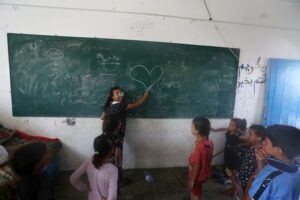While the effects of Israel’s war in Gaza have understandably garnered the most global attention, the Israeli violations against Palestinian childhood in both the West Bank and Gaza have made it clear that Israel has launched a war against an entire generation across Palestine.
Targeting childhood in Gaza
On July 29, the Gaza-based Ministry of Education announced that 39,000 high school students from the Gaza Strip did not take the Tawjihi exam this year, with 10,000 of them killed alongside 400 school teachers.
The Government Media Office said that since the beginning of the war on Gaza, the Israeli army had completely destroyed 125 schools and universities and partially destroyed 336 schools and universities.
The assault on education is mirrored in the genocidal onslaught on all other sectors that make society in Gaza function, from healthcare to food systems to waste management facilities. But one of the most insidious parts of targeting the educational sector is that it aims to erase children’s future.
Sharif Alaa is one of many students originally from al-Shuja’iyya in Gaza City who are now living in the Mawasi “safe zone” in Khan Younis after seven rounds of displacement. At around this time last year in his old neighborhood in Gaza, he was starting his last year of high school and looking forward to applying to university the following year.
Sharif studied well throughout the past year, even amid the genocide, in order to get a high score that would enable him to specialize in the sciences. Sharif clung to his dream even when it seemed impossible given the circumstances, continuing to study throughout his multiple displacements. He held onto hope that at least some students would be allowed to take the exams in certain areas declared “safe” in Gaza.
But he never saw the inside of an exam hall. He listened to the annual radio announcements over the summer with great pain as the highschool tawjihi results excluded the Gaza Strip for the first time in their history. Instead of announcing the results of the students who passed, the Gaza Ministry of Education announced the number of martyred students and teachers in the Gaza Strip.
“They destroyed my future without even harming me physically. So what about those who are injured? I feel indescribable pain because I lost my future. I was waiting to enter a new chapter of my life, and now it’s gone,” Sharif told Mondoweiss.
Ironically, Sharif spent much of his time in school compounds that had been converted into shelters throughout the war, first in northern Gaza, then in the south.
“Schools have lost their value as a place of education,” Sharif said. “They’ve become a place of displacement and loss of home and security.”

“These chairs, these tables, they were used for learning,” Sharif went one. “The school’s mornings were filled with national anthems…Now, classrooms are used as bedrooms housing several families, and people light wood in them to cook their food. This is no longer a school.”
On August 1, UNRWA launched an educational program for children to make up for parts of the school year they had missed. At the very least, it aimed to provide a safe space for children to play, learn, grow, and reunite with old friends.
“In its first phase, UNRWA will expand the ongoing psychosocial support activities, focusing on arts, music, and sports — as well as raising awareness on the risks of explosive ordinance,” UNRWA said in a press release.
“Children in Gaza are traumatized and shocked,” Scott Anderson, UNRWA Director in Gaza, said in the statement. “We are launching the back to learning program today to help children cope and just be children.”


 Palestinians children at an UNRWA school in Deir al-Balah, September 9, 2024. (Photo: Omar Ashtawy/APA Images)
Palestinians children at an UNRWA school in Deir al-Balah, September 9, 2024. (Photo: Omar Ashtawy/APA Images)